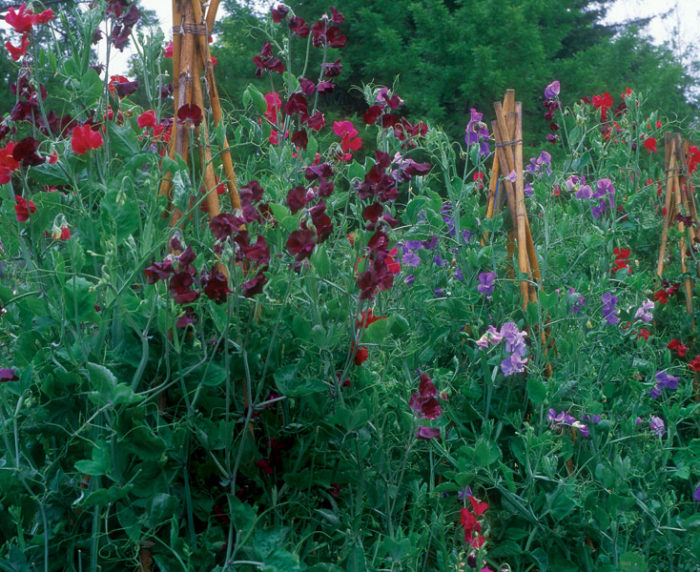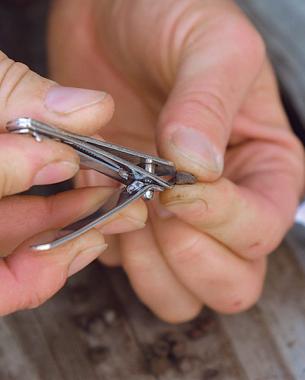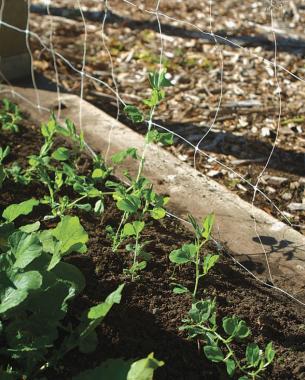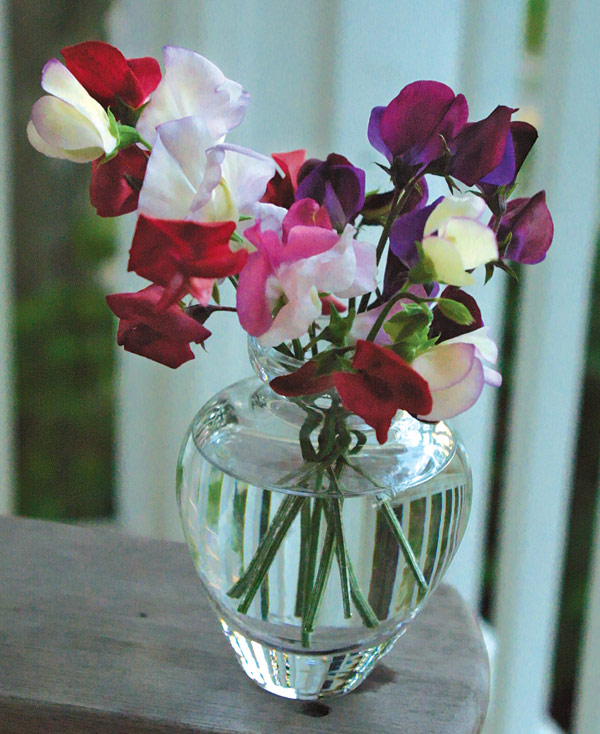How to Grow Sweet Peas
Sow these annuals at the right time, and give them plenty of drainage and air circulation

For me, sweet peas (Lathyrus odoratus cvs.) are the most exquisite of annual flowers. These gorgeous old-fashioned vines bloom for about a month in spring. The long-stemmed sprays of fluted and ruffled blossoms produce an irresistible medley of fragrances that reminds me of jasmine and orange blossoms. A bouquet of scented sweet peas literally perfumes a room.
Despite the fact that growing and enjoying sweet peas as cut flowers is a gardening tradition, these lovely flowers are often labeled “difficult to grow.” I’ve found, however, that if sown at the right time and given the proper conditions, sweet peas are relatively carefree and rewarding to grow. With their wide range of enchanting colors and haunting fragrance, they’re well worth every gardener’s attention.
Sweet peas
Lathyrus odoratus cvs. (LATH-ih-rus oh-dor-AY-tus)
Origins: This fragrant, vining annual has numerous cultivars. The species was discovered by a monk in Italy around 1699.
Conditions: Sweet peas grow in full sun to partial shade and require rich, well-drained soil.
Pests and diseases: Plants need elbow room to promote air circulation, which will hinder mildew problems. Sweet peas are sometimes troubled by birds, slugs, snails, aphids, and thrips.
Propagation: New plants should be grown from seed. In mild winter areas, sow seed in fall or early spring. In cold winter areas, start seed indoors in late winter and transplant in spring.
Maintenance: Sweet peas are heavy feeders, so fertilize them throughout the growing season. Deadheading encourages a longer season of bloom.
Sow seed in cool weather

There are a few commandments to follow to successfully grow sweet peas. Plants must have soil with excellent drainage and full sun to partial shade. Sufficient spacing of plants for good air circulation is important, too, because sweet peas are susceptible to mildew. Young seedlings must also be protected from slugs, snails, and marauding birds until they are 4 to 5 inches tall. Most important, seeds must be sown and grown in cool weather.
In areas with mild winters and hot summers, sweet peas are best sown in fall, after Labor Day. This gives the seeds time to germinate and to develop good root systems, which help the seedlings overwinter and grow rapidly once spring weather and longer days arrive. If you forget to plant in fall, sow the seeds as early as possible in spring in an area with some afternoon shade. In regions with mild winters and relatively cool summers, like the Pacific Northwest, sweet peas can be sown later in spring for late-summer bloom.
In areas with cold winters, sow sweet peas indoors and then transplant them outdoors when weather permits. Sow the seeds in individual 3- to 4-inch-diameter containers to keep the roots from being disturbed while transplanting. It’s important not to plant seedlings in the garden any deeper than they were in containers. If summer heat or humidity comes on fast in your area, direct-sow seeds as soon as the ground can be worked in spring in a spot that gets some afternoon shade. Sweet-pea seedlings are fairly tough and can take a light frost, unlike many other annual seedlings.
Prep seeds and beds first

Once you know when to sow your seed, you’re ready to take action. Well-grown sweet-pea seed will have a germination rate of between 78 and 90 percent. After several years of trialing, I’ve found that nicking the seeds is the best way to enhance germination. Using nail clippers, make a small nick or slice in the outer seed coating. There’s no need to gouge out a piece; simply allow an opening where moisture can enter.
When directly sowing the seed, select a spot with well-drained soil. Before planting, enrich the soil with well-aged manure or compost and erect a well-anchored support system. I’ve grown sweet-pea vines up strings, wire netting, fencing, trellises, and tuteurs. Since their tendrils can’t climb on anything more than 14 inch in diameter, I wrap twine or netting around thicker poles so that the vines can grip.
When sowing seed in the garden, plant the seeds 1 inch deep and 2 to 3 inches apart. If they do not all germinate within two to four weeks, depending on the cultivar, dig down to see if they’re still there. If any have rotted or been eaten, plant more right away because newly sown seeds can catch up quickly to those that have already sprouted. When seedlings are several inches tall, it’s essential to thin them so that they’re 6 to 8 inches apart. This spacing promotes good air circulation, which hinders mildew problems and allows enough room for the vines to mature.

To train your sweet peas to grow on a support, simply point them in the right direction when they’re about 4 to 5 inches long. Once they reach the bottom of their vertical support, they will climb on their own effortlessly.
Feed these vigorous vines regularly throughout their growing and blooming season with a well-balanced fertilizer. Sweet peas dislike wide shifts in soil moisture, so keep the garden soil evenly moist but not soggy. Deadhead blossoms to extend the bloom time and to prevent plants from going to seed.
Besides mildew, sweet peas are susceptible to aphids and thrips when they’re blooming. These delicate flowers do not respond well to insecticidal soaps. I’ve found that a strong spray of water usually deals with the aphids. Blue sticky traps, when hung among the plants, attract the thrips quite successfully.
The story behind sweet peas

Sweet peas were first discovered around 1699, on an island off the coast of Sicily by a botanizing monk, Father Cupani. In the 19th century, an Englishman by the name of Eckford began hybridizing and selecting sweet peas, introducing larger, more beautifully formed, and colorful cultivars, referred to as grandifloras.
In 1901, a naturally mutated sweet pea with even bigger and showier ruffled blossoms was discovered in the English gardens of the Earl of Spencer. These late-blooming and cool-climate Spencer sweet peas were widely embraced by the gardening public, and amateur sweet-pea breeding led to the introduction of plants with a wide range of color with little emphasis on fragrance.
Since then, growers in the United States have developed selections that are better suited to our hot, humid summers. Today, there has been a revival of many of the smaller-flowered, fragrant 19th- and early-20th-century cultivars. Also, through the work of sweet-pea breeders like New Zealand’s Keith Hammett, the American company Bodgers Seeds, and the English company Unwins, many new varieties of sweet peas with beautiful form, color, and intense, full-bodied perfume are being introduced.
A sampling of sweet peas
The elegant flowers of garden sweet peas come in a wide, wonderful color range, from the softest pastels to rich, regal, deep hues. Most selections are tall vines that can reach a height of up to 8 feet in a single season. There are also a few short, nonclimbing, border-type plants that grow to just 2 to 3 feet high. For containers, try diminutive dwarf window-box sweet peas, which cascade and reach 8 to 10 inches long. Here is a sampling of some gardenworthy cultivars to choose from, with information on size and flower color.
Solid colors
‘April in Paris’, 6 to 8 feet, Pale primrose with lilac edges
‘Blue Celeste’, 6 to 8 feet, Pastel blue
‘Electric Blue’, 3 to 4 feet, Azure blue*
‘Royal Wedding’, 6 to 8 feet, Pure white
‘Strawberry Fields’, 6 to 8 feet, Coral-rose
‘Watermelon’, 6 to 8 feet, Watermelon to rosy peach
Mixed colors
‘Cheri Amour’, 6 to 8 feet, Pink, rose, and lavender (mixed/bicolored)
‘Chiffon Elegance’, 6 to 8 feet, White, magenta, pink, and lavender
‘Cupid Color Palette’, 8 to 10 inches, Pink, white, and lavender (mixed/bicolored)
‘Explorer’, 2 to 3 feet, Rose, lavender, blue, scarlet, and white
‘Jewels of Albion’, 6 to 8 feet, Mauve, deep blue, cream, and lavender
‘Pastel Sunset’, 6 to 8 feet, Pink, peach, cream, and lavender-blue
‘Perfume Delight’, 6 to 8 feet, Rose, pale pink, purple, and white
‘Queen of Hearts’, 6 to 8 feet, Burgundy, crimson, magenta, and cream
‘Regal Robe’, 6 to 8 feet, Cream and burgundy
‘Velvet Elegance’, 6 to 8 feet, Maroon, violet-blue, and crimson-red*
‘Bicolored‘America’, 5 to 6 feet, Cherry-red with silvery white striping
‘Cupani’s Original’, 6 to 8 feet, Maroon-purple and orchid-violet
‘Heirloom Cupid’, 8 to 10 inches, Rose-pink and pale pink
‘Mary Lou Heard’, 6 to 8 feet, Lavender and lilac
‘North Shore’, 6 to 8 feet, Claret and violet-blue
‘Painted Lady’, 6 feet, Pink and white
‘Renaissance’, 6 to 8 feet, Magenta-rose and white or pale pink
‘Saltwater Taffy Swirls’, 6 to 8 feet, Swirled in all colors and creams
*Not particularly fragrant






Comments
Great information about growing peas
Log in or create an account to post a comment.
Sign up Log in